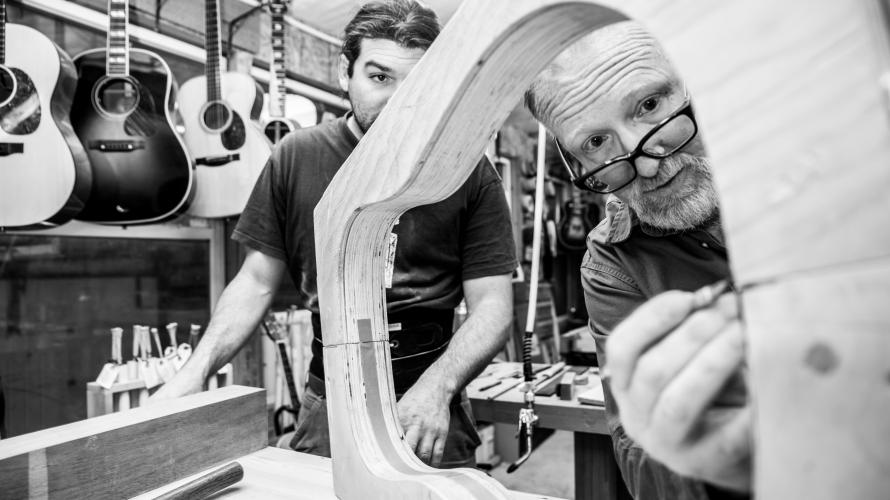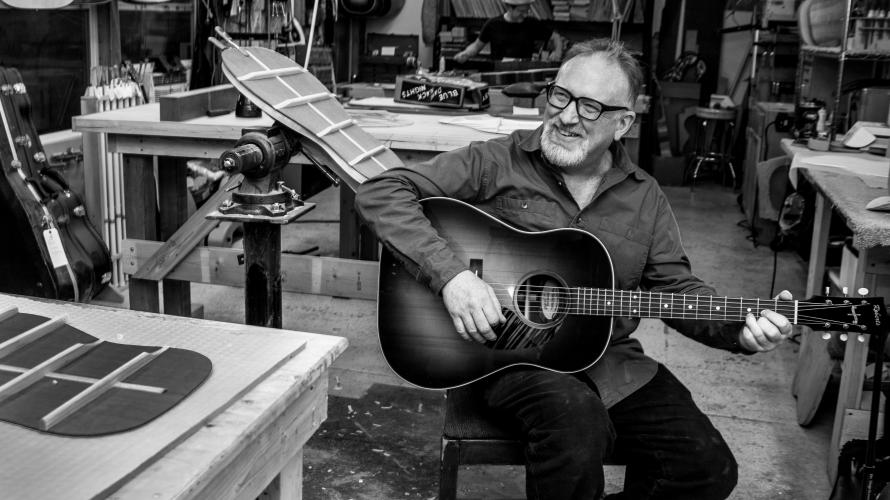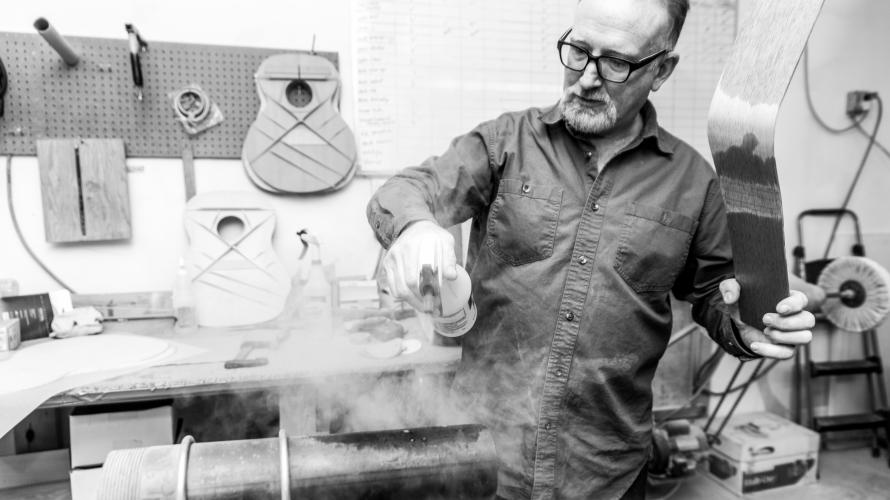


The aroma drifts from the raw interior surface of the timbers. The sensation of strings simultaneously stretched tight and lithe against fingertips. The harmonious jingle of tones accompanying each other, affirming each other’s attribute.
Without question, a guitar made by Daniel Roberts is a multi-sensory piece of artwork. It is an instrument made with a top, back and sides of solid wood intended to produce the most complex sound and to continually improve with age. It is the manifestation of precision and intent, from the heedful selection of the timber, to the drying and evaporation of its dampness, to the mindfulness of its abilities, limitations, and possibilities, and even its appropriate storage.
“The target is to have 6% percent moisture in the wood, and then to let it stabilize,” said Daniel Roberts. “I keep the relative humidity upstairs (in my shop) at 45 to 47 percent. Wood moves when you add or take moisture away, and if you shrink it, the wood will remove the radius, and the top will drop and flatten out. Wood – whether Romanian spruce, Northern Italian, German, or Swiss spruce – has different characteristics, and some wood that grows quickly is often softer, and then there is not as much stiffness within it. Wood has memory in terms of form and of how it moves geometrically, and how it vibrates.”
Thus begins a nuanced conversation with Roberts inside his Belgrade studio, a chat exploring his remarkably wide range of guitar-building knowledge and reflecting the variety of concerns and aesthetic visions that have shaped his artistry over the past three decades.
“Wider grained woods often have much darker late wood lines or grain lines,” continued Roberts, “tending to be much stiffer and more resonant. The stiffer the top wood is, the thinner I can take the (guitar) top so that I can achieve the same strength with less mass, which generally allows me to make a lighter, more resonant, more responsive guitar without losing power, dynamic range, or volume. A factory will generally take all tops to the same thickness dimension, and that thickness will not vary regardless of the stiffness of the top. I vary my top thicknesses based on the stiffness of the top.”
What makes anything in craftsmanship a viable alternative is the integrity of one’s approach to it, it has slightly less to do with the materials, or even the style, but rather it is a kind of energy that comes into the particular sequence of events. A great value in a work of art is that we may better read the artist – in this case, Roberts – and his motives. It seems as if everything that he is thinking and feeling is intensely mirrored in the process.
Indeed, the guitar and its music provide him a much-needed dose of beauty every single day. He gets to revel in the physical splendor of the instrument as an object: the richness and delicate color contrasts of its woods, the multi-dimensional shimmer of a spruce top. There is the visual delicacy of inlays and the collective allure of the instrument’s figure.
“It’s interesting to build a guitar with hand tools, because I think you then understand the process and geometry of the guitar at a much deeper level,” said Roberts, running his fingers across a hand-built dovetail cutter. “I learned to hand plane, chop mortises, and pare wood with razor sharp chisels which neatly dovetailed into my guitar making. I believe hand tools are far more accurate than machine tools and they provide a respect for tradition, and also allow your intuition to have a full measure of say in the process.”
While Roberts’ relationship with building guitars is tied to a series of progressions, his fundamental love of woodworking is inherited. From his grandfather, Christian Roberts, he learned to build benches, small toy guns, gun cabinets, and other pieces of furniture.
“I believe that my idea of what is an acceptable living situation has been skewed by my grandfather,” said Roberts. “When you opened grandpa’s door, at the center was a table saw, a wooden bench, and hand tools. His bedroom was his wood storage room and it was chock-full of woods and wood was stacked against the walls. His living room was his wood shop and his bed was covered with plastic to keep the dust out. Woodworking has been a part of me since I was able to walk next door to his workshop at age 3.”
Born in East Helena, Montana, Roberts signed up for drafting classes in junior high school and woodshop in high school. In college, he studied fine arts while experimenting with wood sculpture. He worked in the forests of Idaho as a tree faller and timber scaler for Plum Creek Timber Company. After leaving the timber industry, he started building instruments with a Bozeman company called Flatiron Banjo and Mandolin Company. Gibson Guitar eventually acquired Flatiron, and Roberts became one of the company’s plant production managers.
Subsequently, Roberts earned employment with the Santa Cruz Guitar Company of California, spending six years living in Santa Cruz, and almost a dozen more working for the company out of his own shop in Montana.
While we romanticize the glittery eureka moments and quantum leaps, it’s seems that most progress happens incrementally. Around this time, Roberts learned advanced chisel, hand planning, and sharpening techniques while apprenticed under a Japanese master carpenter. This experience ingrained in him a deeply symbolic affinity for the slower, handmade techniques. While Roberts currently utilizes some machinery, hand tools still dominate his day, as does a steady reliance on hand bending techniques, and the use of hot hide glue – a cooked down, filtered adhesive of animal connective tissues – for his gluing processes.
“How the parts of the guitar come together, especially the early parts, and where I find myself in the process, I just don’t always know where it is heading,” said Roberts. “Some of it is muscle memory, and some of it is strong movement, applying physics to acoustic theory. But the problem is that you can’t control enough of the variables to make it (guitar-making) true science, so it has to be an art form. And just because the guitar is made by hand doesn’t mean that it shouldn’t have to compete cosmetically with the high-tech companies. I believe I can compete with those companies. I think that being handmade gives my guitars an assertive edge to their tone.”
Indeed, Roberts’ highest ambition lies in excelling in the art of the stringed instrument maker, or luthier. No complete estimate of his talents can be made without the recognition of certain dominating forces always at work behind Roberts’ strings, namely the spiritual approach he brings to all of his creative effort, and his firm belief in a union existent between man and learning.
“Life is the experience of discovery, and it’s not like I now know the answers 30 years later to everything,” said Roberts. “That’s because I’m constantly learning new information, learning that every decision you make along the way affects the product. Learning to not second-guess yourself. But to have confidence in voicing a top or making a neck play right, and have a natural curiosity to find out why it is how it is. Instead of thinking too hard, I have a tendency now to under-think.”
One of the benefits of lone craftsmanship is the uniformity of action.
“It’s hard to have eight people working on a single instrument,” said Roberts. “Each step affects all of the other steps in the guitar, every binding, every carving. With eight guys, the guitar sits on a rack and waits for the next guy to do their step; where I take one instrument all the way through. Every step is cognitive of the previous decision and guides what you do next.”
Roberts’ heart is filled with emotion toward his work, and perhaps it’s not surprising that he has only slight interest in making guitars (or mandolins, which are another one of his specialties) for collectors, hobbyists, or anyone who doesn’t seem genuinely inspired to use, understand, and form a relationship with the guitar. Most, if not all, of his clientele are full-time professional working musicians; many of them are recognizable names and faces, even, well, great icons, such as Eric Clapton and Stevie Nicks. (No, he doesn’t get to meet with each and every client, as many transactions are conducted by a proxy of managers and assistants.) Indeed, Roberts builds for those who are interested in the natural grace, the tremendous strength, and the simple beauty of his instruments.
“When you choose to do something in a way that’s slower and more skill intensive, then you are choosing to build an instrument with a palpable difference, and I call that difference soul. When I string up a guitar, it is like being at a birth. It’s amazing to observe a guitar learning how to be a guitar, and vibrating with sequences under the tension that it has been put under. Many guitars have inspired musicians to new, almost mystical heights. The alchemy between a great guitar and an artist can be almost frightening. Still, the guitar that inspires greatness in one may fall dead in the hands of another.”
Yet, he has no compunction when it comes to parting ways and saying farewell to a completed guitar; he’d rather know that it is serving as a source of radiance, vibrancy, resonance and inspiration for the world.
“Guitars that have been played and vibrated after a year of gigging will have a tone that develops in a different way than if it were just in the closet. It will be an unbelievably different instrument than when it leaves here. It is just getting started, and it will have an evolution. It’s an ongoing living thing and it’ll never be complete. Maybe not alive in the general sense, but certainly developing and changing all of the time, and that’s a very exciting thing to be a part of.”
 Brian D'Ambrosio is a writer/editor living in Missoula, Montana. D'Ambrosio is the author of more than 300 articles and five books related to Montana history, people, and travel.
Brian D'Ambrosio is a writer/editor living in Missoula, Montana. D'Ambrosio is the author of more than 300 articles and five books related to Montana history, people, and travel.


